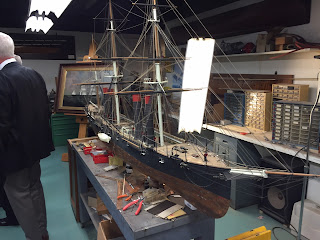 |
| the CO of the Surface Warfare Center (in uniform) and guests |
The Surface Warfare Center is home to the David Taylor Ship Model Tow Tank, an amazing facility where hulls are tested in simulated conditions as scale models, some as long as 50 feet, and are fitted with an array of sensors and towed through varying conditions at different speeds to determine how the real ship, when built, will react to similar conditions.
There are three tanks - the longest being 1,200 feet long; one is shallow (about 9') and still water, one is "deep" at 22' but can make waves the scale equivalent of a state 9 sea (about 50'!), and one is for testing high speed hulls. Sadly, there was nothing happening in two of the tanks, but the high speed one was engaged in testing something and was screened from our view as the classification level was apparently high. And also sadly, due to the restricted security of the space, no pictures were allowed.
Also housed in the facility is PART of the Navy's incredible model collection - the rest of it is scattered around museums and military facilities across the country - and that was most interesting. Many of the models there were built there, and many of the older ones were being restored. What I did not know, but learned at our visit, was that the Navy commissions a model of every new class of ship that joins the fleet. Very impressive.
These models, tucked away in a drawer - several drawers in fact - were what are called "recognition models" from previous wars. Used to train lookouts in recognition of enemy ships from their silhouettes, there are literally hundreds of them.
The drawer on top shown here are for Japanese ships.
The model shop was incredible, the workmanship astonishing, and the gents, the artisans, who worked there was most happy to take a moment to explain what they were doing. Here are a few images from the shop:
The model to the right caught my eye immediately as it was a wonderful rendering of the class of ship - 445 Class (Fletcher Class) destroyer on which I spent most of my six years at sea. A fine ship, fast, lots of guns, and nimble. Sadly, there are none left alive, all having outlived their usefulness. On a personal note, the first one on which I served was launched in the same year in which I was born...
Another model which caught my eye was of the USS Wampanoag, a full-rigged ship equipped with a coal fired steam plant and which held the speed record (17.65kts) for some 25 years following her launch. The model was being carefully restored from her original plans, and from the picture (painting) shown beside her.

Of considerable interest was the fact that the model shop has its own "rope walk" making scale rope necessary to the rigging of the models! The detail in the Wampanoag model is quite amazing:
Many thanks to curator Dana Wegner for his knowledgeable and generous sharing of the Model Shop as well as his fine presentation at lunch about the sinking of USS Indianapolis.
And thanks also to the Navy Historical Foundation for hosting this enjoyable and interesting program.
Until next time,
Fair Winds,
Old Salt







No comments:
Post a Comment